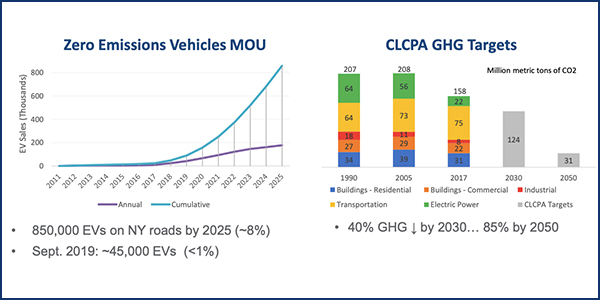The New York Public Service Commission on Thursday approved just over $700 million in spending over the next five years to install more than 50,000 light-duty electric vehicle charging stations throughout the state and to prepare pilot programs to accommodate medium- and heavy-duty vehicles (18-E-0138).
The PSC’s order modifies the EV infrastructure development program included in a white paper published last month by it and the New York State Energy Research and Development Authority (NYSERDA). The paper, on the state’s Clean Energy Standard, recommended installing EV charging stations within 10 miles of disadvantaged communities, which the PSC deemed inadequate, so the commission ordered the stations be built within 1 mile of such communities downstate and within 2 miles in the rest of the state.
“I think it’s smart that the order places the incentives on site location choice, mainly up to developers who have skin in the game,” PSC Chair John B. Rhodes said. “This order finds that make-ready investments by utilities can support and complement charging investments by private developers.”
Most of the money is allocated to the major utilities in New York for a “Make-Ready Program” of incentives for the installation of light-duty EV Infrastructure for both Level 2 and DC fast-charger stations. The investor-owned utilities are Central Hudson Gas and Electric ($21 million), Consolidated Edison ($234 million), New York State Electric and Gas ($64 million), Niagara Mohawk Power ($112 million), Orange and Rockland Utilities ($19 million) and Rochester Gas & Electric ($31 million).
“Today’s action shows that New York is serious about promoting electric vehicles. The scale of this program is beyond any prior efforts, and it recognizes the need to install vehicle chargers widely around the state. It is a huge step for EVs — and for New Yorkers that are thinking about buying an EV,” Anne Reynolds, executive director of the Alliance for Clean Energy New York, said in a statement.
Focus on Environmental Justice
Kathy Harris of the Natural Resources Defense Council said in a blog post that “the order puts a much-needed focus on ensuring that all New Yorkers have access to clean transportation by developing a $85 million competitive program for innovative projects that will increase clean transportation in environmental justice communities. The investment will consider programs such as electric car sharing and ride sharing, something that was recommended specifically by NRDC and Sierra Club.”
Commissioner Diane Burman voted for the order but said she did not favor having the PSC look to the Climate Action Council to define environmental justice.
“As it may or may not affect the utilities and others that we regulate, and what we are doing from a financial perspective for access to ratepayer dollars, it is really premature and inappropriate for us to say that whatever they decide on the environmental justice definition is good by us,” Burman said.
The Climate Action Council was created under the Climate Leadership and Community Protection Act. It works with regulators, state agencies and NYISO to transition the state’s power sector and entire economy away from fossil fuels and toward renewable energy. (See NY Climate Action Council Looks at Deep Decarbonization.)
The estimated aggregate EV Make-Ready Program budget of $582 million through 2025 represents approximately 70% of the total anticipated make-ready costs of $828 million, the PSC said. The 70% figure represents the anticipated overall program reimbursement when factoring in projects at both the 90% level and the 50% level, the rate depending on meeting program criteria.
The utilities will recover program costs through a combination of rate base and surcharges. In addition, program costs will be allocated to all customer classes based on transmission and distribution revenues, the order said.
Not So Fast
Commissioner John Howard echoed Burman’s remarks on the need for continued diligence on overseeing program implementation and said that planning five years out for “massive EV adoption, in this case an additional 800,000 new vehicles in four years, and millions by 2040,” may not be the best approach in a fast-changing industry.
“The goal is not more EV infrastructure, but rather the goal is more EVs,” Howard said. “While this initiative is important, and big in scale, it is just a component of a larger electric transportation policy that needs to be built out in its entirety, because certain aspects of moving toward an electrified transportation system will impact other aspects of the system.”
Howard said that most experts agree that in the near term, 80 to 90% of EV charging will be done at home or at a convenient workplace location.
“Given that EV technology is changing rapidly, I want to emphasize that this is an enormously dynamic technology, particularly in regard to the range of light-duty vehicles, most of which in the next 18 to 24 months will have a range of at least 250 miles per charge,” Howard said.
He also cautioned on one of the biggest issues confronting the future of EV remote charging, which is the handling of the actual purchase of energy at remote charging stations.
“Currently, the Department of Agriculture and Markets oversees the regulation of devices dispensing fuel for vehicles; however, unlike liquid fuels, which are physically measurable as to the exact quantity and quality of the fuel purchased, electric sales offer unique technical challenges,” Howard said.
In addition to the inspection and enforcement associated with the new EV program, there also is a derived authority that is given to counties and New York City, he said.
“I believe we will have to spend a great deal of time bringing those entities up to speed to match the commerce that we expect,” Howard said. “We are intending to install tens of thousands of new places of commerce that will need to be inspected and monitored. To that extent, I do appreciate the inclusion of a multiagency working group to review the current practices and give guidance to the commission on future actions regarding commerce.”




